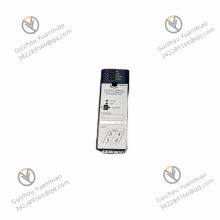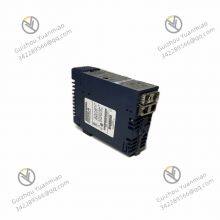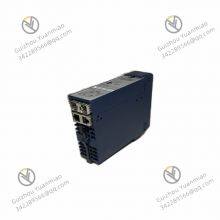GE IC695PNC001 Network Communication Processing Module

I. Module Positioning and Functional Overview
The IC695PNC001 is a network communication processing module in GE PACSystems RX3i series, primarily used to achieve conversion between different network protocols and data interaction in industrial automation systems. Its core functions include:
Serving as an interface between the RX3i system and external networks (e.g., Ethernet, serial networks), supporting multi-protocol communication;
Handling high-speed data transmission, protocol conversion, and network management to enable seamless connection between PLCs, host computers, and third-party devices;
Supporting redundant network configuration to enhance system reliability, suitable for scenarios requiring high communication stability (e.g., manufacturing production lines, process control).
II. Hardware Architecture and Key ComponentsNetwork Interface Unit
Interface Types: Typically includes 2 independent Ethernet ports (RJ45) supporting 10/100 Mbps auto-negotiation; some models can expand serial ports (RS-232/485);
Physical Layer Design: Built-in isolation transformers resist electromagnetic interference, ensuring stable communication in industrial environments;
Redundancy Support: Supports Ethernet ring networks (e.g., SRP/HSR) or link redundancy, automatically switching to backup paths when the primary network fails.
Protocol Processing Unit
Data Processing and Caching Module
CPU and Memory: Built-in high-performance processor and large-capacity RAM support real-time data processing and caching (e.g., FIFO buffers) to prevent data loss;
Data Mapping Table: Configurable input/output data areas associate network data with RX3i CPU register addresses (e.g., %I, %Q areas).
Communication Control Logic Unit
Interrupt Handling: Supports network event interrupts (e.g., data arrival, network failure), triggering real-time PLC program responses;
Flow Control: Avoids network congestion through IEEE 802.3x flow control, optimizing large-data-volume transmission efficiency.
Status Indication and Diagnostic Unit
LED Indicators: Displays power, network connection status, data transmission activity, and fault information (e.g., link disconnection, protocol errors);
Diagnostic Functions: Supports network topology scanning, packet loss rate monitoring, link quality diagnosis, and records abnormal events via module logs.

III. Analysis of Core Working Principles
The working process of IC695PNC001 can be divided into four stages: network access, protocol parsing, data interaction, and system integration:
Network Access and Protocol Identification
The module connects to the industrial network via Ethernet ports, auto-negotiating speed and duplex mode;
After receiving network packets, it identifies target protocols (e.g., CIP protocol for EtherNet/IP) based on header information (e.g., IP protocol number, port number).
Data Parsing and Format Conversion
Parses packets according to protocol rules (e.g., extracting function codes and register addresses from Modbus TCP);
Converts network data into formats recognizable by the RX3i system (e.g., mapping binary data to PLC input registers), as shown in the example:
Network packet (Modbus TCP) → Parsed into [Function code 03, Start address 100, Data length 2] → Mapped to %I100-%I101
Data Interaction with RX3i System
Input data flow: Network data → Module cache → Written to CPU input area (%I) via backplane bus;
Output data flow: Data from CPU output area (%Q) → Backplane bus → Module encapsulates into network packets → Sent to external network;
Real-time interaction mechanism: Synchronizes data via periodic scanning (e.g., 10ms cycle) or event triggering (e.g., when data changes).
Network Management and Redundancy Control
Redundant network configuration: When using dual Ethernet ports, the module supports link aggregation (LACP) or primary-backup redundancy, automatically switching to the backup port and updating the routing table if the primary port fails;
Network topology management: Supports DHCP client/server mode and static IP configuration, compatible with different network architectures (e.g., star, ring).

IV. Key Technical Features and Advantages
Multi-protocol compatibility: Supports mainstream industrial communication protocols, enabling connection of devices from different vendors (e.g., Siemens, Schneider controllers) without additional gateways;
High-speed data transmission: Single-port maximum throughput up to 100 Mbps, suitable for high-real-time scenarios (e.g., SCADA data acquisition, remote I/O control);
Redundancy and reliability: Supports network link redundancy and module hot standby (requires collaboration with RX3i redundant systems), reducing downtime risks;
Flexible configuration tools: Visually configures network parameters, protocol mapping tables, and diagnostic parameters via GE Machine Edition software.
V. Typical Application ScenariosIndustrial Network Integration
Connects RX3i PLCs with SCADA systems (e.g., Wonderware, Intouch) to enable real-time production data monitoring;
Acts as an EtherNet/IP slave station to exchange data with master controllers (e.g., Rockwell PLC).
Cross-protocol Communication
Connects Modbus RTU devices (e.g., intelligent instruments, frequency converters) to Ethernet, converting them to Modbus TCP protocol via the module;
Connects serial devices (e.g., barcode scanners, printers) with PLCs to achieve real-time production data recording.
Remote Monitoring and Maintenance
Connects to the factory LAN via Ethernet, supporting remote programming and fault diagnosis (e.g., viewing module status via a Web interface);
Enables remote device debugging with VPN functionality (requires software support).

VI. Collaborative Work with Other Modules
Collaboration with CPU modules: Exchanges data with the CPU in real time via the RX3i backplane bus, with communication logic controlled by CPU programs (e.g., data transmission trigger conditions);
Collaboration with I/O modules: Processes local alarm outputs during network anomalies in conjunction with digital I/O modules (e.g., IC695MDL640);
Collaboration with safety modules: Serves as a communication node in safety systems, transmitting safety-related data (e.g., emergency stop signals, safety door status) to safety PLCs.
VII. Conclusion
The core value of the IC695PNC001 module lies in seamlessly connecting the RX3i system to industrial networks through multi-protocol conversion and high-speed data processing, enabling device interconnection and data sharing. Its hardware redundancy design and industrial-grade reliability make it a key component of communication architectures in complex automation systems, particularly suitable for scenarios requiring cross-network collaborative control or remote monitoring.
 III. Analysis of Core Working PrinciplesNetwork Access and Protocol IdentificationData Parsing and Format ConversionData Interaction with RX3i SystemNetwork Management and Redundancy Control
III. Analysis of Core Working PrinciplesNetwork Access and Protocol IdentificationData Parsing and Format ConversionData Interaction with RX3i SystemNetwork Management and Redundancy Control IV. Key Technical Features and Advantages
IV. Key Technical Features and Advantages VI. Collaborative Work with Other Modules
VI. Collaborative Work with Other Modules












































